Medicinal plants of India - An Overview
jagatyevam anoushadham
na kinchit vidyate dravyam
vashaannaarthayagayoh'
"There is nothing in this universe, which is non-medicinal, which cannot be made use of for
many purposes and by many modes."
This is the traditional definition of medicinal plants given in Ashtaanga Hrdaya, the
definitive Ayurvedic text written by the Buddhist monk Vagbhata in 600 A.D.
This definition rightly suggests that "in principle" all plants have a potential medicinal
value, although in practice a plant is referred to as medicinal when it is so used by some
system of medicine.
There is evidence since early Vedic period (Atharva Veda) of plants being used for a wide
range of medicinal purposes. They have in fact been used in a continuous unbroken tradition
for over four millennia. The table below gives the approximate number of medicinal plants
recorded in various traditional texts written across the millennia.
Medicinal plant use in India is still a living tradition. This is borne out by the fact that
there exist around a million traditional, village-based carriers of herbal medicine
traditions in the form of traditional birth attendants, visha vaidyas, bonesetters, herbal
healers and wandering monks. Apart from these specialised carriers, there are millions of
women and elders who have traditional knowledge of herbal home-remedies and of food and
nutrition. As per recent statistics published by the Health Ministry, Government of India,
there are 600,000 licensed and registered traditional physicians in India today.
Distribution and classification
The Indian System of medicine today uses across the various systems i.e. folk and codified
around 8,000 species of plants. The maximum numbers of medicinal plants are utilized by the
folk traditions, followed by Ayurveda, Siddha, Unani, Homeopathy, Tibetan and Modern
respectively.
In terms of life forms, medicinal plants are equally distributed across habits viz., trees,
shrubs and herbs. Roughly, one third of the known medicinal plants are trees and equal
proportion shrubs and the remaining one-third herbs, epiphytes, grasses and climbers. Very
small proportions of the medicinal plants are lower plants like lichens, ferns, and algae.
The majority of medicinal plants are higher flowering plants.
Preliminary analysis of the distribution pattern shows that medicinal plants are distributed
across diverse habitats and landscape elements. Around 70 per cent of India's medicinal
plants are found in the tropical zone, mostly in the forests of the Western and Eastern
Ghats, the Vindhyas, Chotta Nagpur plateau, Aravalis, the Terai region in the foothills of
the Himalayas and the North East. Less than 30 per cent of these medicinal plants are
confined to the temperate and colder zones although species of great medicinal value occur
in some of these habitats. A quick analysis of the available data shows that the proportion
of medicinal plants recorded in the dry and moist deciduous tropical forests is higher as
compared to those recorded in the tropical evergreen forests.
The knowledge of the Indian people about plants and plant products is not based on the
application of Western categories of knowledge and approaches to studying natural products,
like chemistry and pharmacology. It is based on sophisticated, indigenous knowledge category
called "Dravya Guna Shastra".
Given below are some of the basic biological parameters on which plants are studied.
Parameters for admission of a plant into the Ayurvedic Materia Medica:
1. Nomenclature Scheme: (habit, habitat, morphological features, etc.)
2. Parts used (leaf, flower, fruit, seed, gum, resin, latex, root, bark, etc.)
3. Methods of purification
4. Contra-indications.
5. Effect on physiological systems (Dosha karma)
6. Effect on body tissues (Dhatu karma)
7. Effect on organs
8. Effect on excretory system
9. Qualities (Guna)
10. Metabolic activity (Veerya)
11. Post-digestive effect (Vipak)
12. Drug computation class (Gana)
13. Drug therapeutic class (Yoga)
14. Processing strategies (Kalpana)
15. Specific products and their applications
On the basis of such schemes of study as outlined above the pharmaceutical and therapeutic
applications of thousands of plants have been worked out. The outcome of this approach has
resulted in around 25,000 brilliantly designed plant drug formulations, in the codified
tradition, in a variety of dosage forms. Although the traditional processing technology is
pre-industrial, the range of methods of processing plants and principles of drug design are
sophisticated.
In the folk system a rough estimate suggests that over 50,000 herbal drug formulations have
been developed by the 4600 odd ethnic communities of India across her diverse ecosystems for
a very wide range of applications. The value of folk knowledge can be dramatically
illustrated from a single example of Phyllanthus niruri, which is used by village
communities in Southern India for treatment of jaundice. The application of this plant for
treatment of Viral Hepatitis B has been validated and patented by an American Noble
prizewinner.
According to an All India Ethnobotanical Survey conducted by the Ministry of Environment
(1985-90), there are 6000 species of medicinal plants in India which can be used by
traditional practitioners in tribal areas and other village communities.
In the local tradition, the internal fleshy mucilaginous jelly of the aloe plant known
locally as Kattarvazha, korphad kumari etc., is used externally on burns and wounds and
orally for any gynaecological disorder.
In Karnataka, a decoction of the bark of the Astonia scholaris a flowering branch is used in
virtually every household at the onset of the monsoon to prevent malarial fevers.
The neck of the turtle is sometimes used for the treatment of a pro-lapsed rectum or uterus.
Adatoda Vassica or Adusi Vasa, as it is locally known, is a common treatment for coughs and
to stop bleeding in the case of piles or dysentry.
Boerhavia diffusa (punarnava) is commonly used in the treatment of oedema as it has diuretic
properties. It is also used to combat anaemia, particularly during pregnancy.
Nomenclature
The nomenclature of medicinal plants is itself very rich. One can illustrate this with the
example of "Guduchi" i.e. Tinospora cordifolia. It has 52 meaningful names. See the box
below which gives the list of the Sanskrit names and some of their meanings. Such examples
suggest the passion with which the Indian people have indulged in the study of medicinal
plants.
The plant name Guduchi which comes from the Sanskrit root gudu rakshane (that which
protects) has the following synonyms:
amruthavalli, (a weak-stemmed plant which acts as an elixir),
mandali (Circular)
kundali (stem gets entangled with twiners)
naagakumaari (stem has a twining nature like that of a young snake)
tantrika (spreading nature of the plant, looks after the health of the body)
madhuparni (honey - like leaves)
chadmika (thick foliage which forms a canopy)
vatsaadani (leaves eaten by calves)
shyaama (smoky due)
dhaara (young stems have slight longitudinal grooves)
chakralakshana (wheel - like appearance of cross section)
vishalya (no thorns or other irritant appendages, removes diseases)
chinna, chinnaruha, chinnad bhava, chinnangi (these four names indicate the capacity of the
cut bits of stem to withstand or endure severe adverse conditions and to produce buds to
develop new plants)
abdikaahvaya (reservoir of water)
amrutha (person using the plant would live long and be healthy)
soma (powerful action of the plant as an elixir)
rasaayani, vayastha, jeevanti (three names indicate rejuvenating nature of the plant)
jvaranaasini, jvaraari (two names indicate the specific use of the plant in fevers)
bhishapriya, bhishakjita (favourite of the physicians or that which has won the favour of
physicians)
vara (best among medicines)
soumya (benevolent in action)
chandrahassa (crescent moonlike smile)
devanirmita (created by God)
amruthasambhava (originated from nectar)
surakritha (created by God).
The depth of study of plants is clearly reflected in their manifold applications. It is not
uncommon to see several "hundred" applications of a particular plant used or in various
formulations for different purposes. This can be illustrated by the example of a very common
plant called amla or gooseberry (Emblica officinalis).
There are nearly 180 formulations of Amla. These formulations are used in a wide range of
disorder e.g., eye disorders like conjunctivitis, vision disorders; hyperacidity, rheumatic
disorders, abdominal disorders, jaundice, hiccough, breathing disorders, fever, cough, ear
disorders, good for hair growth and texture, skin disorders, intoxication due to alcohol and
gynecological disorders.
SOME AYURVEDIC PLANTS OF INDIA
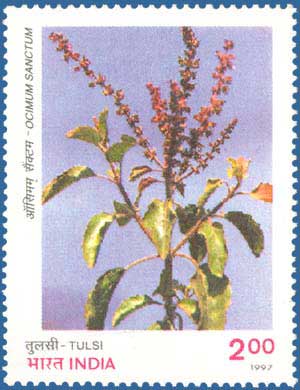
Tulsi - Ocimum Sanctum Linn. (Laminaceae) is a plant worshipped for its medicinal values since time immemorial. The juice of the leaves is used in catarrh and bronchitis and applied to the skin in ring-work and other cutaneous diseases. An infusion of the leaves is given to children in gastric disorders. A decoction of the root is given as disphoretic in malarial fever. It drives away mosquitoes.
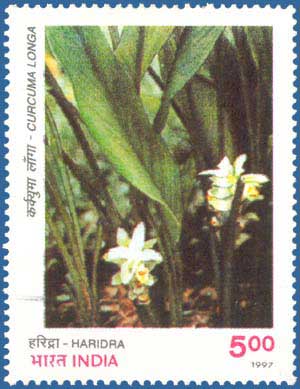
Haridra - Curcuma Longa Llinn. (Zingiberaceae) is a perennial herb, native of Southern Asia and cultivated throughout India. The drug is considered as carminative in cases of diarrhoea and intermittent fevers, in disorders of blood, in affections of liver and jaundice, in non- tubercular respiratory diseases. A decoction of the rhizome is applied to relieve catarrh, scabies and certain skin diseases. The drug is externally applied in pains and bruises and internally administered in disorders of the blood. Haridra can grow at all places ranging from sea level to an altitude of 1,220 metres but is very sensitive to atmospheric temperature.
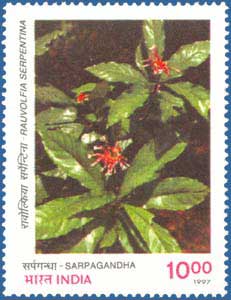
Sarpagandha - Rauvoifia Serpentina Linn. (Apocynaceae) is probably one of the important contributions of ancient Indian medicine. The alkaloid reserpine present in the roots of this plant, has been proved to be an effective remedy against hypertension. Ayurvedic texts also describe its sedative and hypnotic actions. The drug has been effectively tried in cases of high blood pressure, insanity and schizophernia. It is widely distributed in the sub-Himalayan tract, Assam, lower hills of Gangetic plains, eastern and Western Ghats, and some parts of Central India.
The drug Rauvoifia consist of the air-dried roots of the plant. Besides the roots, its liquid extract, the dried extract and the tincture are official in Indian Pharmacopoeia.
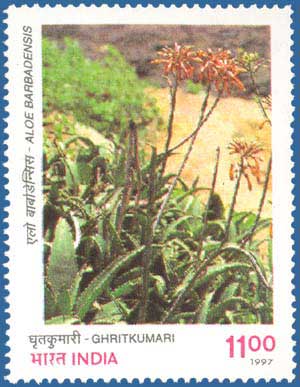
Ghrit kumari - Aloe. Barbadensis Mill. (Liliaceae)
is a native of North Africa and found in semi-wild state in all parts of India, from the dry westward valleys of Himalayas upto Kanyakumari.
The leaf juice is used in dyspepsia, burns, colic, hyperadenosis, hepatopathy, splenopathy, skin disease, constipation, vitiated condition of vata and pitta, abdominal tumours, dropsy, carbuncies, sciatica, lumbago and flatulence. The oleo-gum, is used for local application in painful inflammation, burns, chronic ulcers and catarrhal and purulent opthaimia.
The first day cover carries the depiction of "Shri Dhanwantri" who is revered as the originator of Ayurveda. Considering the relevance, the government has created a department of Indian System of Medicine and Homoeopathy to develop, promote, research and increase awareness to these systems of medicine.
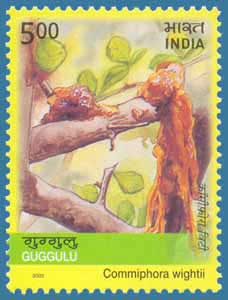
Guggulu (Commiphora wightii) is an armed shrub or small tree found in the arid and semi-arid zones of India, particularly Rajasthan. The oleo gum resin from its stem constitutes an important therapeutic agent used in the treatment of various categories of ailments like neurological conditions, leprosy, skin diseases, heart ailments, cerebro vascular diseases and hypertension.
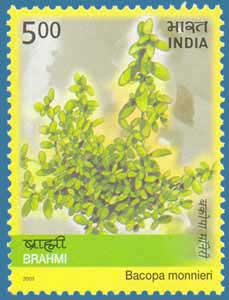
Brahmi (Bacopa monnieri) is a herb that spreads on ground, having fleshy stems and leaves. It is found in moist or wet places in all parts of India. Brahmi is useful for treating the diseases of the brain and to improve memory power. Brahmi-formulations are prescribed in rheumatism, mental disorders, constipation and bronchitis. It is also a diuretic.
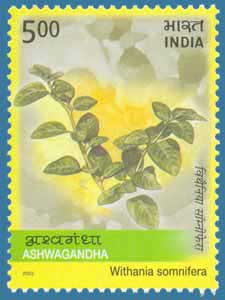
Ashwagandha (Withania somnifera) is a small or medium sized shrub found in the drier parts of India. It is a nervine tonic, anabolic and aphrodisiac. It is used also to treat general weakness and rheumatism.
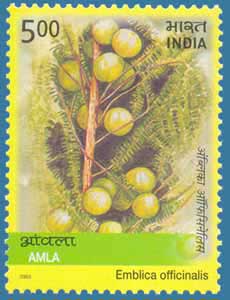
Amla (Emblica officinallis) is a medium sized deciduous tree found throughout India. It yields a globose pale yellow fruit known for its varied medicinal properties. It is regarded as an astringent, digestive, carminative, laxative, anti-pyretic and tonic. It is prescribed in colics, jaundice, hemorrhages, flatulence and many other disorders.
| | | |
| Crab's Eye | Gum arabic tree | Catechu tree | Apamarga |
| |  |
| |
| Aconite | Ativisa | Sweet flag | Adhatoda vasica |
 |  |  |  |
| Bael tree | Siris tree | Jivaka | Aloe plant |
| |
|
|
|
| Dita fark | Tanduliyakam | Greater cardamn |









